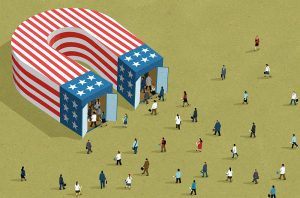John Griffin in Harvard Magazine:
 WHEN Harvard president Lawrence S. Bacow stressed the vital role of immigrants in both higher education and the economy during his October installation address, economist William R. Kerr’s research team cheered. The D’Arbeloff-Class of 1955 professor of business administration, Kerr studies the future of work, with a particular focus on high-skilled immigrants and their impacts on the U.S. economy. At a time when immigration provokes fierce debate in American public life, he argues in The Gift of Global Talent (Stanford) for reforms to streamline the U.S. immigration system and attract more overseas talent.
WHEN Harvard president Lawrence S. Bacow stressed the vital role of immigrants in both higher education and the economy during his October installation address, economist William R. Kerr’s research team cheered. The D’Arbeloff-Class of 1955 professor of business administration, Kerr studies the future of work, with a particular focus on high-skilled immigrants and their impacts on the U.S. economy. At a time when immigration provokes fierce debate in American public life, he argues in The Gift of Global Talent (Stanford) for reforms to streamline the U.S. immigration system and attract more overseas talent.
Using databases of Nobel Prize-winners, inventors, and college graduates, Kerr has found that immigrants contribute an outsized portion of U.S. innovation. Since 1901, for example, 33 percent of the country’s Nobel laureates have been immigrants. In 2014, 40 percent of America’s doctoral degrees were awarded to noncitizens. Data from the Longitudinal Employer-Household Dynamic database suggest that more than a quarter of U.S. entrepreneurs were born overseas, this number having risen steadily since at least 1995. Such patterns are more difficult to discern among inventors (patents do not list the holders’ immigration status), but Kerr uses algorithms to approximate inventors’ ethnicities from their first and last names, yielding insights into workforce patterns within firms even when immigration patterns cannot be observed directly. Using this method, Kerr estimates that likely immigrants accounted for roughly 29 percent of U.S. patents in 2017, up from just 9 percent in 1975. Immigrant output has increased faster than immigration itself, and this growth is clear across sectors.
Kerr writes that “powerful ideas are the main force behind long-term economic growth” and presents evidence that high-skilled immigration is crucial to this process. Such powerful ideas are especially likely to emerge in what he calls “talent clusters,” places like Cambridge or Silicon Valley, where specialized industries congregate—and where immigrants often come to work.
More here.
